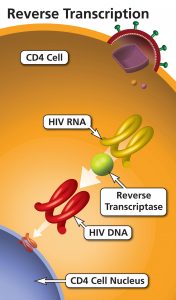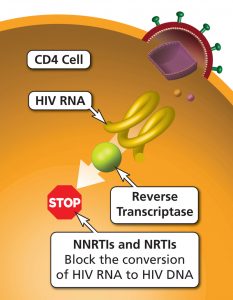OVERVIEW
HIV attacks cells within the body’s immune system. To spread, the virus needs to enter these cells and make copies of itself. The copies are then released from these cells and infect other cells. Treatment with nucleoside reverse transcriptase inhibitors (NRTIs) is one way to help stop the virus from replicating and control HIV infection. NRTIs are also called nucleoside analogues or nukes.
NRTIs are one of 6 classes of antiretroviral drugs (ARVs) used to treat HIV as part of antiretroviral therapy (ART). ARVs interfere with the ability of a virus to multiply or reproduce. To treat HIV, NRTIs work by blocking an enzyme HIV needs to make copies of itself.
Normally, HIV enters certain cells in the body that are part of the immune system. These cells are called CD4 cells, or T cells. After HIV enters the CD4 cells, the virus begins to copy itself. To do so, it needs to copy its RNA—the virus’s genetic makeup—into DNA. This process is called reverse transcription and requires an enzyme called reverse transcriptase.
NRTIs prevent the virus’s reverse transcriptase from accurately copying its RNA into DNA. Without DNA, HIV can’t make copies of itself.
AVAILABLE NRTIs
Currently, there are several NRTIs that the Food & Drug Administration (FDA) has approved for HIV treatment. Here are some examples:
-
- lamivudine (Epivir)
- abacavir sulfate (Ziagen)
- tenofovir disoproxil fumarate (Viread)
- emtricitabine (Emtriva)
- tenofovir alafenamide fumarate (Vemlidy)—not taken alone for HIV treatment, only available in combination medications
NRTIs are also available in several combination medications. Combination HIV medicines contain 2 or more HIV medicines from 1 or more drug classes.
TIPS FOR USAGE
All NRTIs come as tablets that are taken by mouth. Treatment with NRTIs usually involves taking 2 NRTIs as well as 1 drug from a different class of ARVs.
Your healthcare provider will select treatment based on test results that give important information about your specific condition. If you have taken ARVs before, your healthcare provider will also factor this in when deciding on treatment options.
Once HIV treatment starts, the medication needs to be taken on a daily basis exactly as instructed. This is the most important way to help control your HIV. The following tips can help ensure adherence to treatment:
-
- Take the medication at the same time each day.
- Use a weekly pill box that has compartments for each day of the week. These boxes are available in most pharmacies.
- Combine taking the medication with a task that is performed every day. This makes it part of your daily routine.
- Use a calendar to check off the days when medication was taken.
- Set an alarm reminder for taking the medication on a phone or computer.
- Download an app that can give reminders when it’s time to take the medication. A search for medication reminder apps will provide many options.
- Ask a family member or friend to give reminders for take the medication.
- Arrange to receive text or phone messaging reminders from your healthcare provider.
POTENTIAL SIDE EFFECTS
NRTIs can cause side effects. Some side effects are more common than others. Your reaction depends in part on which drugs your healthcare provider prescribes and what other drugs you take.
In general, newer NRTIs, such as tenofovir, emtricitabine, lamivudine, and abacavir, cause fewer side effects than older NRTIs, such as didanosine, stavudine, and zidovudine (these are not used frequently anymore due to their serious side effects).
Common side effects usually go away with time. These can include:
-
- headache
- nausea
- vomiting
- diarrhea
- upset stomach
If you are taking an NRTI and start to have uncomfortable side effects, don’t stop taking the drug without talking to your healthcare provider first. Pausing or changing ARVs can do more harm than good. The medications may become less effective or the virus may become resistant to the drugs altogether. This means the drugs won’t work anymore to treat the virus.
THE BOTTOM LINE
Nucleoside reverse transcriptase inhibitors (NRTIs) are medications that have made HIV management possible. It is important that the appropriate antiretroviral drug (ARV) regimen for HIV treatment is carefully selected, depending on your medical history, other illnesses, prior HIV treatment, stage of infection, and individual preferences.
If your healthcare provider has prescribed NRTIs it’s important to stick to your treatment plan to manage HIV. If you have side effects from antiretroviral therapy (ART), there are some tips you can try to manage them. More importantly, talk to your healthcare provider for suggestions and recommendations. Your healthcare provider may also change your treatment plan to help relieve side effects.
Reviewed June 2025
Print PDF






